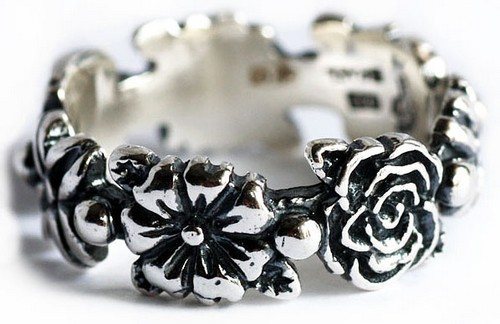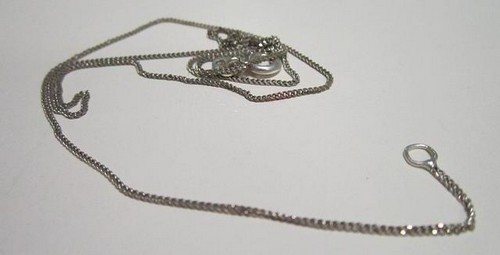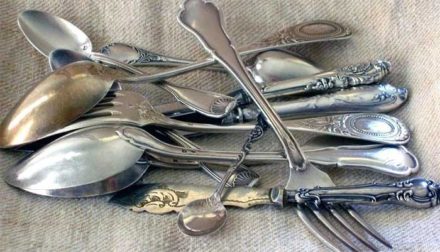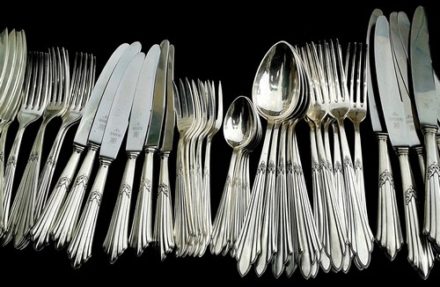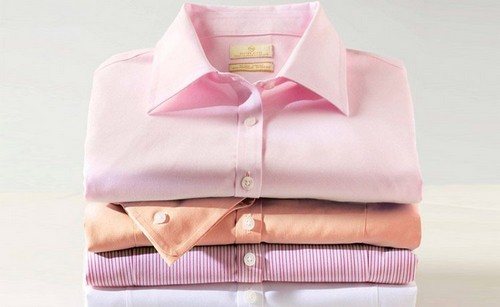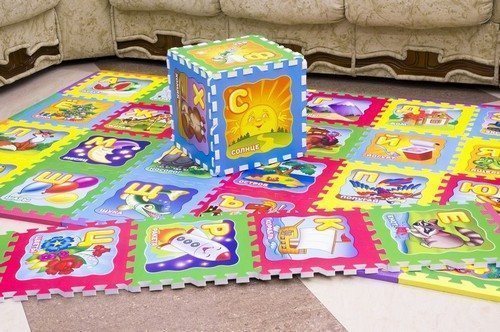Silver has always been valued and was a sign of wealth and good taste. The healing properties of silver help with digestion, thin the blood and kill toxins in the body. It was from silver cups that great leaders and kings drank in order to protect themselves from poisoning. Over time, dishes, jewelry and other items begin to change their color - darken, which is a natural reaction of the metal's vital activity. Cleaning silver seems like an insurmountable task. But thanks to folk and professional methods, returning the natural color of silver will become commonplace.
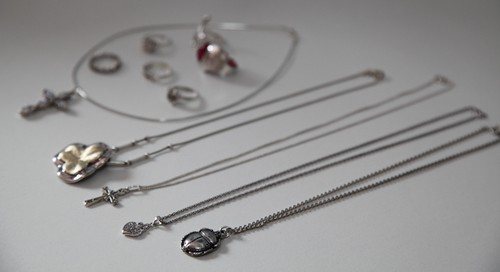
- Why silver darkens
- General rules for cleaning silver
- How to choose a method
- Home methods
- Soda
- Foil
- Ammonia
- Hydrogen peroxide
- Vinegar
- Tooth powder and paste
- Citric acid
- Other acid
- Salt
- Coca Cola
- Potatoes
- Olive oil
- Eraser
- Boiling
- Chalk
- Egg
- Ash and cinders
- Sour milk
- Ketchup
- Lipstick
- Cosmetic powder
- Professional products
- Cleaning liquid
- Napkins
- Cleaning paste
- Special devices
- Features of cleaning different items made of silver
- Cross
- Chain
- Earrings
- Ring
- Table
- Blackened
- Matte
- Gilded
- With stones
- With pearls
- With enamel
- Rhodized
- Coins
- Nuances of removing certain contaminants
- Blackness
- Dirt
- Yellowness
- Iodine
- Soot
- After hydrogen sulfide
- Horn plaque
- How to achieve silver shine after cleaning
- How to keep silver clean
- Video tips
Why does silver darken?
Ancestors believed that metal darkens when it absorbs all the bad things from the owner’s body, thereby helping the person to cleanse himself. Now researchers have scientific evidence of a change in the color of the noble metal. There are two reasons for blackening of silver items:
- Oxidation with oxygen. When interacting with oxygen, oxidation occurs, since now dishes are made not from pure silver, but from various alloys that produce an organic reaction. In nature, expensive metals do not oxidize, therefore, the worse the sample, the darker the products become.
- Sulfide formation. Increased humidity and human contact release hydrogen sulfide, for example, when the body sweats. This, in turn, reacts with the metal and leads to a color change. Upon contact, a thin film of sulfide is formed, which gives the metal a dark color.
But not only humans can be a source of hydrogen sulfide. Onions, eggs, cabbage contain chemical compounds that change the color of silver. Aggressive household chemicals can also cause discoloration.
General rules for cleaning silver
When choosing any silver purification method, it is important to adhere to a number of general rules:
- Products should not be brought to a catastrophic state. When the first stains appear, you should immediately clean the metal.
- Before the main process, it is important to clean the silver from dirt, grease, and cosmetics. To do this, place the products in a bath of soapy liquid and hold for half an hour.
- Radiated objects rarely change color, but they are easily scratched by soda, brushes and salt.
- 925 silver, the most expensive and valuable, must be given to professionals in a jewelry workshop, otherwise they can be damaged using home methods.
- It is better not to clean fragile items with brushes; a velvet cloth is suitable for Argentum.
It is important to treat all precious metals with care, keep them in a separate, dark place and remember to check for any discoloration.
How to choose a method
There are two types of removal of plaque from precious metals: home and professional.
To clean silver, it is enough to audit the available means at hand and choose the most optimal method. The use of aggressive methods of influence is carried out only on the coarsest alloys and simple decorations, so as not to damage them. Complex, expensive items with stones and engravings require a careful approach. The choice of method is influenced by the sample size of the product, weight, presence of complex elements (gilding, stones, engraving) and degree of contamination.
The lack of effects from home methods or difficult cases lead housewives to professional cosmetics, which can be purchased with specialized mixtures and pastes for removing stains from silver.
Home methods
Housewives often choose home methods for cleaning silver due to the simplicity and availability of folk recipes, as well as the ecology of the selected products, which do not leave chemicals on precious metals.
Soda
Using baking soda is one of the effective ways to clean the kitchen. It also works well to remove tarnish on silver.
- Pour liquid soda until a slurry appears, apply it to a sponge or cloth and clean the products until the plaque is removed. Then rinse thoroughly to remove stains.At the same time, you need to be careful with matte and smooth objects; traces of soda may remain.
- Dilute 2 standard spoons of soda per half liter of water solution. Wait until it boils, remove from heat, place things in a container. You also need to add a piece of foil there. After 10-20 minutes, remove the products and rinse.
Soda baths and boiling are often used when processing not only silver, but also gold.
Foil
Cut kitchen foil into medium squares and add a teaspoon of moistened baking soda to the middle of each square. Then put things in and cover with foil to make an envelope. Throw into boiling water for 10-20 minutes, remove, cool, and then rinse and wipe with a special cloth.
Ammonia
The effectiveness of ammonia has been proven by more than one generation of housewives and jewelry lovers. To remove plaque, just take 2 standard spoons of the specified alcohol, dilute it with a liter of water, then put all the Argentum things into the resulting solution. Another way is to add a teaspoon of hydrogen peroxide and a drop of detergent to the existing solution. Immerse the products in it for 10-20 minutes and then rinse.
Hydrogen peroxide
One of the aggressive treatments is suitable for simple, low-grade items. Dilute peroxide at 3% concentration in a warm water bath. Place all darkened metals there. After 5 minutes, remove and rinse and dry. When working with peroxide, you should wear gloves to avoid getting burned.
Vinegar
Pour vinegar (3 percent solution) into a deep plate. Then heat the silver items a little and lower them into the liquid. After 15 minutes, remove and rinse in distilled liquid and polish.If there is no specified percentage of vinegar, you can take a 6% solution and dilute it with water.
You can also wipe with a cloth soaked in vinegar, but to achieve effectiveness, it is better to dip it in heated water.
Tooth powder and paste
Teeth whiteners clean cutlery perfectly. Paste removes sulfide film well. You can take a small amount of paste, a soft toothbrush or cloth and rub gently.
Citric acid
An aggressive substance that can even harm silver. If used correctly, this is impossible. You need to dissolve 100 g of dry acid in half a liter of liquid. At the same time as silver items, throw in copper wire (a small piece), heat in a steam bath. After 15 minutes, take it out and rinse with distilled liquid. Then polish.
Other acid
Formic acid, like other acids, can be used in processing silver. In a warm water bath, dilute 5% formic acid. Hold for 5 minutes, rinse and dry.
Salt
Pour two tablespoons of salt into half a liter of liquid. Drown everything blackened in the solution and hold for 2-3 hours or bring to a boil for 20 minutes. Then rinse and dry
Coca Cola
The famous lemonade has long been used to remove dirt and clean dishes. The drink is also effective in cleaning precious metals. Dip items in a container filled with fizzing liquid for 20 minutes. Another way is to bring the drink to a boil and put silver in it for 15-20 minutes.
Potatoes
An effective folk method is cleaning with potatoes. Grind a couple of potatoes until they form a paste, add water to the resulting mixture and soak for 10-15 minutes.Afterwards, strain the solution and immerse objects in it for 20 minutes.
This method works well for minor stains.
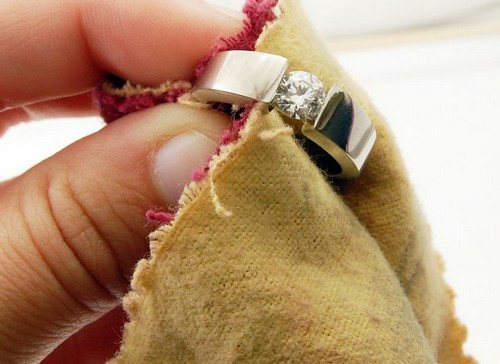
Olive oil
Olive oil is used when you need to clean expensive silver items with a slight coating. Apply a little oil to cotton wool or a cloth and wipe the stained areas on the products with it. This method is only suitable for minor darkening; in other cases, the oil may not cope.
Eraser
The eraser is used as the last stage of cleaning, for example, after boiling or treating with soda. Using an eraser, simply erase the remaining stains on the products until they disappear completely.
Boiling
Boiling is used for deep contamination when other methods do not work. Most often, soda and salt solutions, as well as foil, are used for boiling. Some housewives add household chemicals.
To boil, take 2 tablespoons of baking soda, 2 tablespoons of salt, and a little dishwashing detergent. Place all this in a saucepan and add 0.5 liters of water. Bring the solution to a boil, and then place silver items in it. After 5 minutes, remove, rinse and wipe dry.
Chalk
The chalk is crushed and mixed with ammonia. The resulting mixture is applied to the silver with a brush or sponge and rubbed until the plaque is removed.
Egg
Place the decorations in the liquid in which the eggs were previously boiled and leave for 15-20 minutes. Take it out and wipe it with a cloth.
Take a raw egg, separate the yolk from the white, then soak the yolk in cotton wool and wipe things with it. Leave in the yolk for a while and then rinse.
Ash and ashes
Dip a damp cloth into ash or ash and apply it to things, then rub with ash until dirt and stains are completely removed. Then rinse and dry.
Curdled milk
Place silver items in regular yogurt and leave for 20 minutes. Then rinse and dry.
Ketchup
Place things in ketchup for 15-20 minutes, take a sponge or cloth and wipe all hard-to-reach places, as well as dirt. Leave for another 5-10 minutes. Then wash in soapy water and polish.
Lipstick
No matter how paradoxical it may sound, lipstick cleans small objects well: rings, earrings, pendants. Apply lipstick to a napkin or cloth, then wipe the jewelry with it, then rinse thoroughly.
Cosmetic powder
Regular women's powder cleans silver items well. You need to pour a little powder onto a cloth and rub the jewelry with it until the stains disappear. This method is well suited for small silver jewelry.
Professional products
Jewelry cleaning products are highly effective and therefore are used not only among professionals. The solution, wipes and paste can be bought in specialized stores.
Cleaning liquid
Professional liquid is sold in a set with soft brushes. It is enough to immerse things for 20-30 seconds in the prepared solution. Then rinse and dry. The liquid is reusable and can be used several times. The only negative is the not very pleasant smell.
Napkins
Special, professional wipes will help you achieve a mirror shine. They are impregnated with active substances that remove cloudy plaque from objects. Napkins can be used for any items containing precious stones. Each metal has its own wipes, so do not wipe gold.
Cleaning paste
It is good to treat cutlery and other things made from argentum with professional paste. It removes all oxidation, cloudy deposits and other defects, forming a transparent, protective layer.
Special devices
The product market is not limited to professional products. Jewelers have created small, professional, ultrasonic devices for cleaning jewelry. All you have to do is place your items in a special bath, add water and press the “start” button. After 20 minutes, remove, rinse and dry.
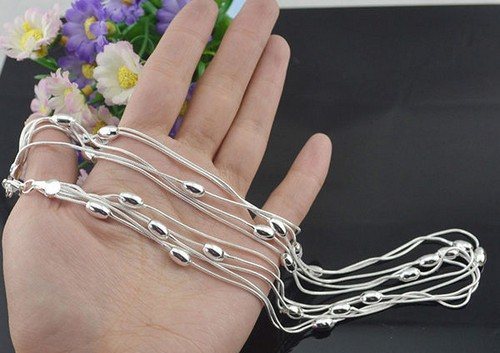
Features of cleaning different silver products
Some types of jewelry require special, careful handling, as they have a high quality alloy, as well as additions in the form of stones and workmanship.
Cross
The pectoral cross, a complex item with engravings and workmanship, requires careful handling. It is forbidden to use hard sponges and brushes. First you need to soak the cross in soapy liquid, then proceed to the processing process. Make a paste of soda and water, blot the resulting mixture with a cloth, clean the cross until the stains are completely removed. Lipstick and olive oil will also work.
Chain
The chain, like the cross, darkens most often, since many people take a bath without removing silver items. Line the bottom of the pan with foil. Pour water into it, add 2 tablespoons of soda, put the items and put on fire. Boil for 5 minutes. It is important to lay out the chain carefully and evenly without tangling it, as you can break the chain when unraveling. You also need to pay attention to the hidden and reverse sides of the weave, as there may be traces of dirt and darkening there.
Earrings
As mentioned above, earrings with stones should be taken to jewelers for processing.When treating at home, you should choose gentle methods. Take lipstick, add it to a cloth and clean the earrings; if stains remain, soak them in soapy water. Allergy sufferers should treat the locks with alcohol to prevent suppuration.
Ring
Rings should be treated with gentle methods, paying special attention to the inside. If the ring has engravings or stones, then it is better to take it to professionals. At home, lipstick and olive oil will do.
Dining room
Kitchen appliances are made from the cheapest alloys, so they can be treated with acid, vinegar, boiled and soaked in soda. Nothing will happen to the products. The only exception is a matte device, which can be damaged by brushes.
Blackened
The processing of blackened products must be approached as carefully as possible so as not to damage the fragile top layer. There are 2 ways to use this decoration:
- Soap and soda solution. Dilute 1 standard spoon of baking soda and a small piece of soap in a water solution. Place Argentum items there for half an hour. After this bath, remove and rinse with water.
- Peeling with potatoes. Peel 2-3 potatoes and place them in a container with water. Place blackened silver there for 3-4 hours. Then rinse and dry.
Matte
Cutlery and jewelry with a matte finish should not be treated with any acids, as this may damage the fragile material. Also, when cleaning with brushes, you can damage the surface and leave marks. The ideal option for home cleaning is a gentle, soapy solution in which you should leave the jewelry for about an hour. Then take it out and rinse.
Gold plated
Gold in the composition is one of the types of complex alloys. For it, you need to prepare a soap bath and leave for 15-20 minutes, then add a teaspoon of ammonia and hold for 5 minutes. Then rinse, dry and rub with an eraser if stains remain.
With stones
Careful and painstaking work will go to the owners of jewelry with stones. Some rocks with high density can be boiled and treated with acids. These include emerald, sapphire and aquamarine. Others are better treated with specialized products and not subjected to heat treatment. Good products include: olive oil, lipstick and an eraser. From professional products, you can choose napkins.
With pearls
Pearl jewelry and items with ivory are prohibited from being processed at home. There is a risk of damaging the stones. You can buy professional cleaning napkins. They will not harm the stones and will bring the items to a mirror shine. Many housewives take items with pearls to professionals in a workshop to protect jewelry from processing defects.
With enamel
The fragile and sensitive material does not allow heat treatment, as well as the use of aggressive acids. Folk advice allows using a soap solution. Among professional products, you can choose cleaning wipes.
Rhodium-plated
Experts have invented an alloy that includes rhodium in addition to the main composition. This alloy practically does not darken. Rhodium-plated silver is cleaned only with professional products, so it is better to contact a jewelry workshop and buy ready-made products. At the same time, if the plaque is small, you can hold the metal in a heated liquid for several minutes.
Rhodium-plated silver should not be treated with any acids, powders or detergents. Otherwise, they may destroy the alloy.
Coins
Olive oil, soap solution, soda, salt, citric acid, and tooth powder are suitable for cleaning silver pieces.
Moisten a cloth with ammonia, wipe the coins, then take a slurry of soda and wipe the silver pieces until the stains are completely removed. You can also boil coins with foil according to the method indicated above.
For small stains, you can wipe with olive oil and soak in soapy water.
Nuances of removing certain contaminants
There are impurities that appear only on precious metals, for example, horn silver. To get rid of it, you should pay special attention to the types and causes of contamination.
Black
Blackness is the most common contaminant of precious metals. To get rid of it, you can rub the product with soda, soak it in a saline solution, clean it with lipstick, an eraser or olive oil. The vinegar removal method is also effective.
Dirt
Soap infusion will become an indispensable bleach. You need to grate the soap, dissolve it in water, let the product sit for 30 minutes, then rinse and dry.
Yellowness
One of the most common types of stains. Yellowness may appear even after going to the pool. The reasons for its appearance are the organic reaction of chlorine and iodine. To remove yellowness, you need to put the decorations in a solution with raw potatoes. You can also remove stains with baking soda, olive oil, toothpaste or soap solution.
Iodine
Raw potatoes, soap solution, soda, salt, toothpaste will help destroy iodine stains.You can also use foil envelopes.
Burn
Grind 1 potato, place the potato pulp with juice in a separate bowl. Place items there and leave for 2-3 hours. Afterwards rinse with water.
After hydrogen sulfide
“Foil envelopes,” as well as salt and soda solutions, will help restore shine and whiteness after hydrogen sulfide. Housewives also note the effectiveness of tooth powder.
Horny plaque
A dull, purple tint to jewelry or coins indicates the appearance of horn silver. When processing such things, you need to be extremely careful or contact specialists, since the risk of irretrievable loss is too great. Add ammonia with a concentration of 5% to the water bath, remove it after 5-10 minutes, wipe with a sponge or a special brush. Then rinse and dry.
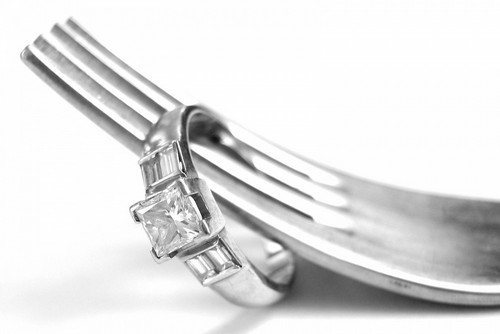
How to make silver shine after cleaning
After the cleaning procedure, you should immediately remove all water or remaining liquid and then polish the products. To do this, you can purchase a special professional polish or cream to create a mirror shine.
Apply liquid to a cloth and polish the products until a mirror effect appears. After this, the polish must be washed off and the items thoroughly wiped until the streaks disappear.
Another method is special polishing cloths. They are used to polish the metal until it shines, but it is important to remember that wipes for gold are not suitable for silver products and vice versa.
How to keep silver pure
To prevent the natural color of various silver items, you need to follow simple rules:
- Create a separate closed place, such as a box. Put ordinary foil in it, and put things on it. Close the lid.It is important to place the box at a harmonious, room temperature.
- It is important to remove jewelry before cosmetic procedures, showers, swimming pools and saunas. Before putting things back on, you need to dry yourself thoroughly and minimize the amount of moisture, creams and other unwanted aggressors.
- Every evening you can wipe all items with specialized wipes and polish to minimize the risk of contamination.
- After eating, you should immediately clean and polish all things. Also, under no circumstances should cutlery be placed in the dishwasher. In this case, there is a threat of losing metals.
By following all the tips, you can keep silver items clean for a long time. It's a good idea to check metals every month for stains.


